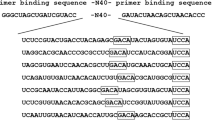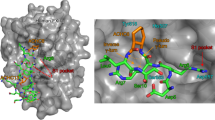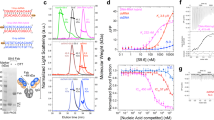Abstract
Reiterative in vitro selection-amplification from random oligonucleotide libraries allows the identification of molecules with specific functions such as binding to specific proteins. The therapeutic usefulness of such molecules depends on their high affinity and nuclease resistance. Libraries of RNA molecules containing 2′amino-(2′NH2)- or 2′fluoro-(2′F)-2′-deoxypyrimidines could yield ligands with similar nuclease resistance but not necessarily with similar affinities. This is because the intramolecular helices containing 2′NH2 have lower melting temperatures (Tm) compared with helices containing 2′F, giving them thermodynamically less stable structures and possibly weaker affinities. We tested these ideas by isolating high-affinity ligands to human keratinocyte growth factor from libraries containing modified RNA molecules with either 2′NH2 or 2′F pyrimidines. We demonstrated that 2′F RNA ligands have affinities (Kd approximately 0.3–3 pM) and bioactivities (Ki approximately 34 pM) superior to 2′NH2 ligands (Kd approximately 400 pM and Ki approximately 10 nM). In addition, 2′F ligands have extreme thermostabilities (Tm approximately 78°C in low salt, and specificities).
This is a preview of subscription content, access via your institution
Access options
Subscribe to this journal
Receive 12 print issues and online access
$209.00 per year
only $17.42 per issue
Buy this article
- Purchase on Springer Link
- Instant access to full article PDF
Prices may be subject to local taxes which are calculated during checkout
Similar content being viewed by others
References
Gold, L. 1995. Oligonucleotides as research, diagnostic, and therapeutic agents. J. Biol. Chem. 270: 13581–13584.
Gold, L., Polisky, B., Uhlenbeck, O., and Yarus, M. 1995. Diversity of oligonucleotide functions. Annu. Rev. Biochem. 64: 763–797.
Green, L., Waugh, S., Binkley, J.P., Hostomska, Z., Hostomsky, Z., and Tuerk, C. 1995. Comprehensive chemical modification interference and nucleotide substitution analysis of an RNA pseudoknot inhibitor to HIV-1 reverse transcriptase. J. Mol. Biol. 247: 60–68.
Klußmann, S., Nolte, A., Bald, R., Erdmann, V.E., and Furste, J.P. 1996. Mirror-image RNA that binds D-adenosine. Nature Biotechnology 14: 1112–1115.
Nolte, A., Klußmann, S., Bald, R., Erdmann, V.E., and Furste, J.P. 1996. Mirror-design of L-oligonucleotide ligands binding to L-arginine. Nature Biotechnology 14: 1116–1119.
Pieken, W.A., Olsen, D.B., Benseler, F., Aurup, H., and Eckstein, F. 1991. Kinetic characterization of ribonuclease-resistant 2′-modified hammerhead ribozymes. Science 253: 314–317.
Pan, W., Craven, R.C., Qiu, Q., Wilson, C.B., Wills, J.W., Golovine, S. et al. 1995. Isolation of virus-neutralizing RNAs from a large pool of random sequences. Proc. Natl. Acad. Sci. USA 92: 11509–11513.
Jellinek, D., Green, L.S., Bell, C., Lynott, C.K., Gill, N., Vargeese, C. et al. 1995. Potent 2′-amino-2′-deoxypyrimidine RNA inhibitors of basic fibroblast growth factor. Biochemistry 34: 11363–11372.
Lin, Y., Qui, Q., Gill, S.C., and Jayasena, S.D. 1994. Modified RNA sequence pools for in vitro selection. Nucleic Acids Res. 22: 5229–5234
Eaton, B.E., Gold, L., and Zichi, D.A. 1995. Let's get specific: the relationship between specificity and affinity. Chemistry & Biology 2: 633–638.
Aurup, H., Tuschl, T., Benseler, F., Ludwig, J., and Eckstein, F. 1994. Oligonucleotide duplexes containing 2′-amino-2′-deoxycytidines: thermal stability and chemical reactivity. Nucleic Acids Res. 22: 20–24.
Kawasaki, A.M., Casper, M.D., Freier, S.M., Lesnik, E.A., Zounes, M.C., Cummins, L.L. et al. 1993. Uniformly modified 2′-deoxy-2′fluoro phosphorothioate oligo-nucleotides as nuclease-resistant antisense compounds with high affinity and specificity for RNA targets. J. Med. Chem. 36: 831–841.
Lesnik, E.A., Guinosso, C.J., Kawasaki, A.M., Sasmor, H., Zounes, M., Cummins, L.L. et al. 1993. Oligodeoxynecleotides containing 2′-O-modified adenosine: synthesis and effect on stability of DNA:RNA duplexes. Biochemistry 32: 7832–7838.
Monia, B.P., Lesnik, E.A., Gonzalez, C., Lima, W.F., McGee, D., Guinosso, C.J. et al. 1993. Evaluation of 2′-modified Oligonucleotides containing 2′-deoxy gaps as antisense inhibitors of gene expression. J. Biol. Chem. 268: 14514–14522.
Rubin, J.S., Osada, H., Finch, P.W., Taylor, W.G., Rudikoff, S., and Aaronson, S.A. 1989. Purification and characterization of a newly identified growth factor specific for epithelial cells. Proc. Natl. Acad. Sci. USA 86: 802–806.
Finch, P.W., Rubin, J.S., Miki, T., Ron, D., and Aaronson, S.A. 1989. Human KGF is FGF-related with properties of a paracrine effector of epithelial cell growth. Science 244: 752–755.
Miki, T., Bottaro, D.P., Fleming, T.P., Smith, C.L., Burgess, W.H., Chan, A.M.L., et al. 1992. Determination of ligand-binding specificity by alternative splicing: two distinct growth factor receptors encoded by a single gene. Proc. Natl. Acad. Sci. USA 89: 246–250.
Staiano-Coico, L., Krueger, J.G., Rubin, J.S., D'limi, S., Vallat, V.P., Valentine, L. et al. 1993. Human keratinocyte growth factor effect in a porcine model of epidermal wound healing. J. Ex. Med. 178: 865–878.
Brauchle, M., Madlener, M., Wagner, A.D., Angermeyer, K., Lauer, U., Hofschneder, P.H. et al. 1996. Keratinocyte growth factor is highly overex-pressed in inflammatory bowel disease. Am. J. Pathol. 149: 521–529.
Finch, P.W., Pricolo, V., Wu, A., and Finkelstein, S.D. 1996. Increased expression of keratinocyte growth factor messenger RNA associated with inflammatory bowel disease. Gastroenterology 110: 441–451.
Ishii, H., Hattori, Y., Itoh, H., Kishi, T., Yoshida, T., Sakamoto, H., et al. 1994. Preferential expression of the third immnoglobulin-like domain of K-sam product provides keratinocyte growth factor-dependent growth in carcinoma cell lines. Cancer Res. 54: 518–522.
Katoh, M., Hattori, Y., Sasaki, H., Tanaka, M., Sugano, K., Yazaki, Y. et al. 1992. K-sam gene encodes secreted as well as transmembrane receptor tyrosine kinase. Proc. Natl. Acad. Sci. USA 89: 2960–2964.
Yi, E.S., Yin, S., Harclerode, D.L., Bedoya, A., Bikhazi, N.B., Housley, R.M. et al. 1994. Keratinocyte growth factor induces pancreatic ductal epithelial proliferation. Am. J. Pathol. 145: 80–85.
Housley, R.M., Morris, C.F., Boyle, W., Ring, B., Biltz, R., Tarpley, J.E. et al. 1994. Keratinocyte growth factor induces proliferation of hepatocytes and epithelial cells throughout the rat gastrointestinal tract. J. Clin. Invest. 94: 1764–1777.
Ulich, T.R., Yi, E.S., Longmuir, K., Yin, S., Biltz, R., Morris, C.F. et al. 1994. Keratinocyte growth factor is a growth factor for type II pneumonocytes in vivo. J. Clin. Invest. 93: 1298–1306.
Yi, E.S., Bedoya, A.A., Lee, H., Kim, S., Housley, R.M., Aukerman, S.L. et al. 1994. Keratinocyte growth factor causes cystic dilation of the mammary glands of mice. Interaction of keratinocyte growth factor, estrogen, and progesterone in vivo. Am. J. Pathol. 145: 1015–1022.
Ulich, T.R., Yi, E.S., Cardiff, R., Yin, S., Bikhazi, N., Biltz, R. et al. 1994. Keratinocyte growth factor is a growth factor for mammary epithelium in vivo. The mammary epithelium of lactating rats is resistant to the proliferative action of keratinocyte growth factor. Am. J. Pathol. 144: 862–868.
Yi, E.S., Shabaik, A.S., Lacey, D.L., Bedoya, A.A., Yin, S., Housley, R.M. et al. 1995. Keratinocyte growth factor causes proliferation of urothelium in vivo. J. Urol. 154: 1566–1570.
Yan, G., Fukabori, Y., Nikolaropoulos, S., Wang, F., and McKeehan, W.L. 1992. Heparine-binding keratinocyte growth factor is a candidate stromal to epithelial cell andromedin. Mol. Endo. 6: 2123–2128.
Culig, Z., Hobisch, A., Cronauer, M.V., Radmayr, C., Trapman, J., Hittmair, A. et al. 1994. Androgen receptor activation in prostatic tumor cell lines by insulin-like growth factor-l, keratinopyte growth factor, and epidermal growth factor. Cancer Res. 54: 5474–5478.
Bottaro, D.P., Fortney, E., Rubin, J.S., and Aaronson, S.A. 1993. A keratinocyte growth factor receptor-derived peptide antagonist identifies part of the ligand binding site. J. Biol. Chem. 268: 9180–9183.
Woese, C.R., and Pace, N.R. 1993. Probing RNA structure, function, and his-tory by comparative analysis, pp. 91–117 in The RNA world. Gesteland, R.F. and Atkins, J.F. (eds.). Cold Spring Harbor Laboratory Press, Cold Spring Harbor, NY.
Wyatt, J.R., and Tinoco, I. Jr. 1993. RNA structural elements and RNA function in pp. 465–496 The RNA world. Gesteland, R.F. and Atkins, J.F. (eds.). Cold Spring Harbor Laboratory Press, Cold Spring Harbor, NY.
ten Dam, E., 1992. Structural and functional aspects of RNA pseudoknots. Biochemistry 31: 1665–11676.
Du, Z., Giedroc, D.P., and Hoffman, D.W. 1996. Structure of the autoregulatory pseudoknot within the gene 32 messenger RNA of bacteriophages T2 and T6: a model for a possible family of structurally related RNA pseudoknots. Biochemistry 35: 4187–4198.
Qiu, H., Kaluarachchi, K., Du, Z., Hoffman, D.W., and Giedroc, D.P. 1996. Thermodynamics of folding of the RNA pseudoknot of the T4 gene 32 autoregulatory messenger RNA. Biochemistry 35: 4176–4186.
Shen, L.X. and Tinoco, I. Jr., 1995. The structure of an RNA pseudoknot that causes efficient frameshifting in mouse mammary tumor virus. J. Mol. Biol. 247: 963–978.
Tuerk, C., MacDougal, S., and Gold, L. 1992. RNA pseudoknots that inhibit human immunodeficiency virus type 1 reverse transcriptase. Proc. Natl. Acad. Sci. USA 89: 6988–6992.
Ringquist, S., Jones, T., Snyder, E.E., Gibson, T., Boni, I., and Gold, L. 1995. High-affinity RNA ligands to Escherichia coli ribosomes and ribosomal protein S1: comparison of natural and unnatural binding sites. Biochemistry 34: 3640–3648.
Binkley, J., Alien, P., Brown, D.M., Green, L., Tuerk, C., and Gold, L., 1995. RNA ligands to human nerve growth factor. Nucleic Acids Res. 23: 3198–3205.
Lorsch, J.R., and Szostak, J.W. 1994. In vitro selection of RNA aptamers specific for cyanocobalamin. Biochemistry 33: 973–982.
Hilbers, C.W., Robillard, G.T., Shulman, R.G., Blake, R.D., Webb, P.K., Fresco, R. et al. 1976. Thermal unfolding of yeast glycine transfer RNA. Biochemistry 15: 1874–1882.
Kaighn, M.E., Narayan, K.S., Ohnuki, Y., Lechner, J.F., and Jones, L.W. 1979. Establishment and characterization of a human prostatic carcinoma cell line (PC-3). Investigative Urology 17: 166–23.
Weissman, B.E., and Aaronson, S.A. 1983. BALB and Kirsten murine sarcoma viruses alter growth and differentiation of EGF-dependent balb/c mouse epidermal keratinocyte lines. Cell 32: 599–606.
Caputo, J.L., Hay, R.J., and Williams, C.D. 1979. The isolation and properties of an epithelial cell strain from rhesus monkey bronchus. In Vitro 15: 222–223.
Tuerk, C., and Gold, L. 1990. Systematic evolution of ligands by exponential enrichment: RNA ligands to bacteriophage T4 DNA polymerase. Science 249: 505–510.
Fitzwater, T., and Polisky, B. 1996. A SELEX primer. Methods Enzymol. 267: 275–301.
Feng, D. and Doolittle, R.F. 1987. Progressive sequence alignment as a prerequisite to correct phylogenetic trees. J. Mol. Evol. 25: 351–360.
Jaeger, J.A., Turner, D.H., and Zuker, M. 1989. Improved predictions of secondary structures for RNA. Proc. Natl. Acad. Sci. USA 86: 7706–7710.
Jaeger, J.A., Turner, D.H., and Zuker, M. 1990. Predicting optimal and suboptimal secondary structure for RNA. Methods Enzymol. 183: 281–306.
Zuker, M. 1989. On finding all suboptimal folding of an RNA molecule. Science 244: 48–52.
Jellinek, D., Lynott, C.K., Rifkin, D.B., and Janjic, N. 1993. High-affinity RNA lig-ands to basic fibroblast growth factor inhibit receptor binding. Proc. Natl. Acad. of Sci. USA 90: 11227–11231.
Carey, J., Cameron, V., de-Haseth, P.L., and Uhlenbeck, O.C. 1983. Sequence-specific interaction of R17 coat protein with its ribonucleic acid binding site. Biochemistry 22: 2601–2610.
Miki, T., Fleming, T.P., Bottaro, D.P., Rubin, J.S., Ron, D., and Aaronson, S.A. 1991. Expression cDNA cloning of the KGF receptor by creation of a transforming autocrine loop. Science 251: 72–75.
Bottaro, D.P., Rubin, J.S., Ron, D., Finch, P.W., Florio, C., and Aaronson, S.A. 1990. Characterization of the receptor for keratinocyte growth factor. J. Biol. Chem. 265: 12767–12770.
Gill, S.C., Weitzel, S.E., and von-Hippel, P.H., 1991. Escherichia coli σ70 and NusA proteins I. Binding interactions with core RNA polymerase in solution and within the transcription complex. J. Mol. Biol. 220: 307–324.
Sambrook, J., Fritsch, E.F., and Maniatis, T. 1989. Molecular cloning: a laboratory manual, 2nd ed. Cold Spring Harbor Laboratory, Cold Spring Harbor, NY.
Author information
Authors and Affiliations
Corresponding author
Rights and permissions
About this article
Cite this article
Pagratis, N., Bell, C., Chang, YF. et al. Potent 2′-amino-, and 2′-fluoro-2′- deoxyribonucleotide RNA inhibitors of keratinocyte growth factor. Nat Biotechnol 15, 68–73 (1997). https://doi.org/10.1038/nbt0197-68
Received:
Accepted:
Issue Date:
DOI: https://doi.org/10.1038/nbt0197-68
This article is cited by
-
Screen and Optimization of an Aptamer for Alexandrium tamarense—A Common Toxin-Producing Harmful Alga
Marine Biotechnology (2023)
-
Current Advances in Aptamer-based Biomolecular Recognition and Biological Process Regulation
Chemical Research in Chinese Universities (2022)
-
Potential applications of aptamers in veterinary science
Veterinary Research (2021)
-
Quantitative detection of neurotransmitter using aptamer: From diagnosis to therapeutics
Journal of Biosciences (2020)
-
Recent advances in understanding oligonucleotide aptamers and their applications as therapeutic agents
3 Biotech (2020)



